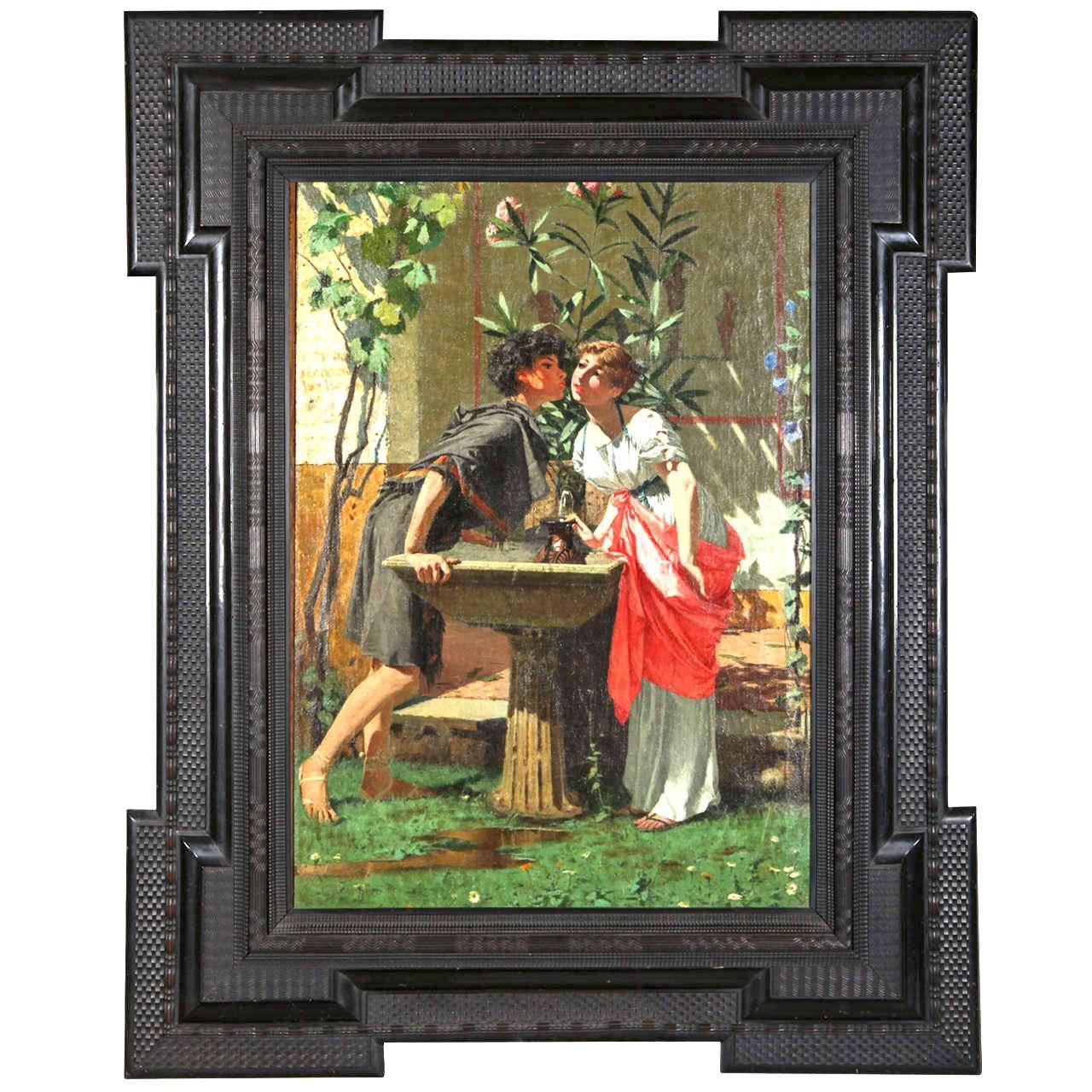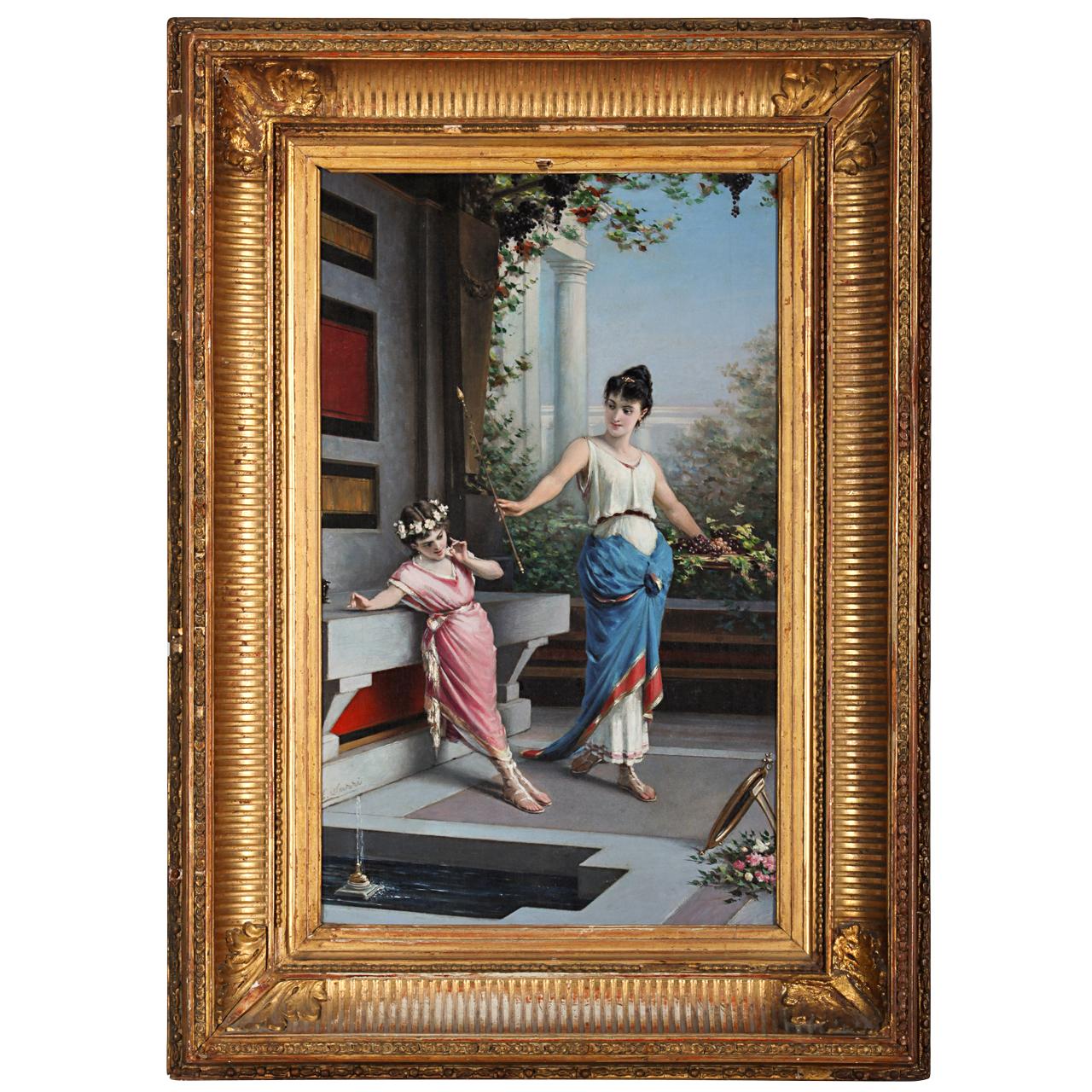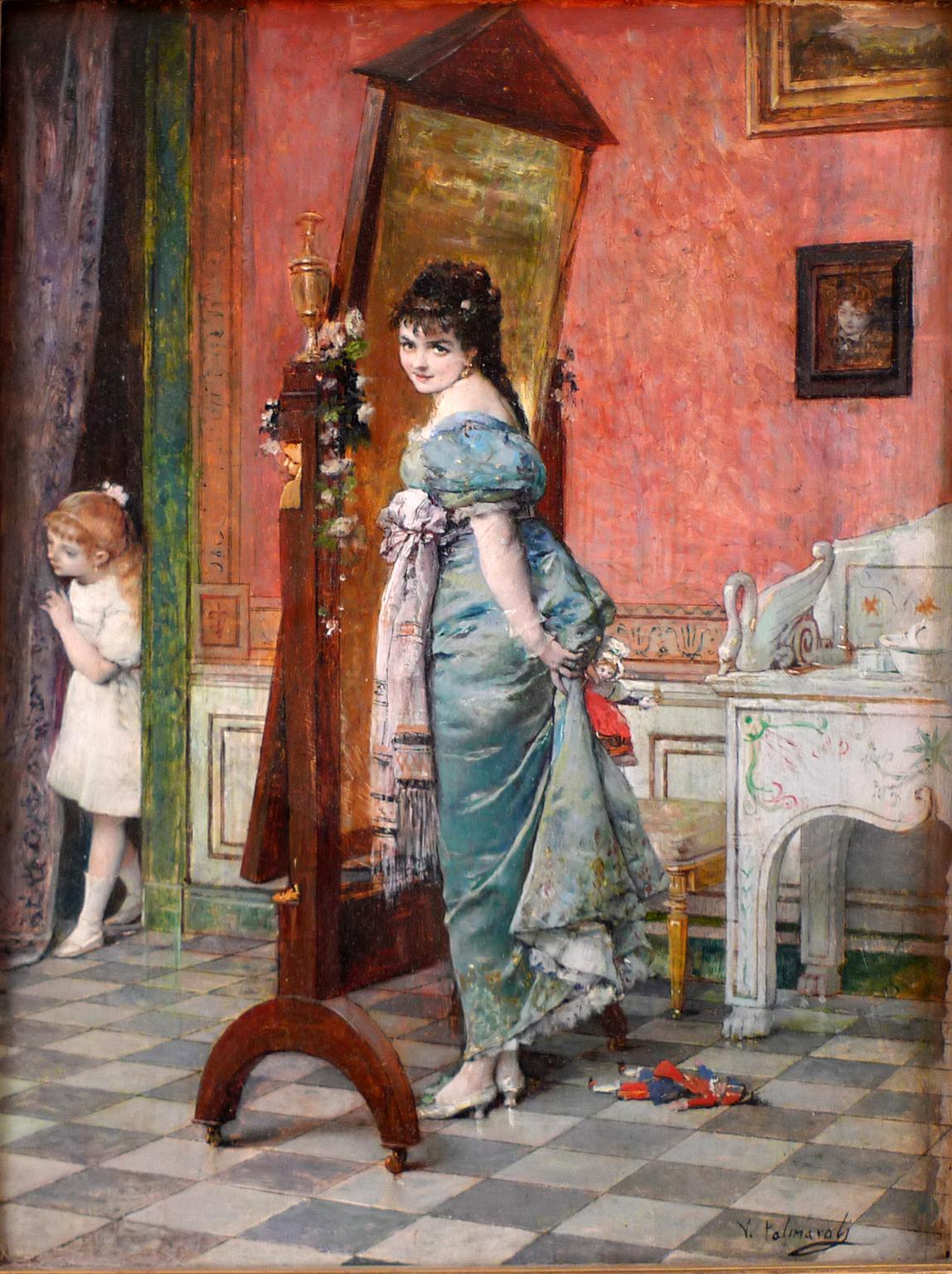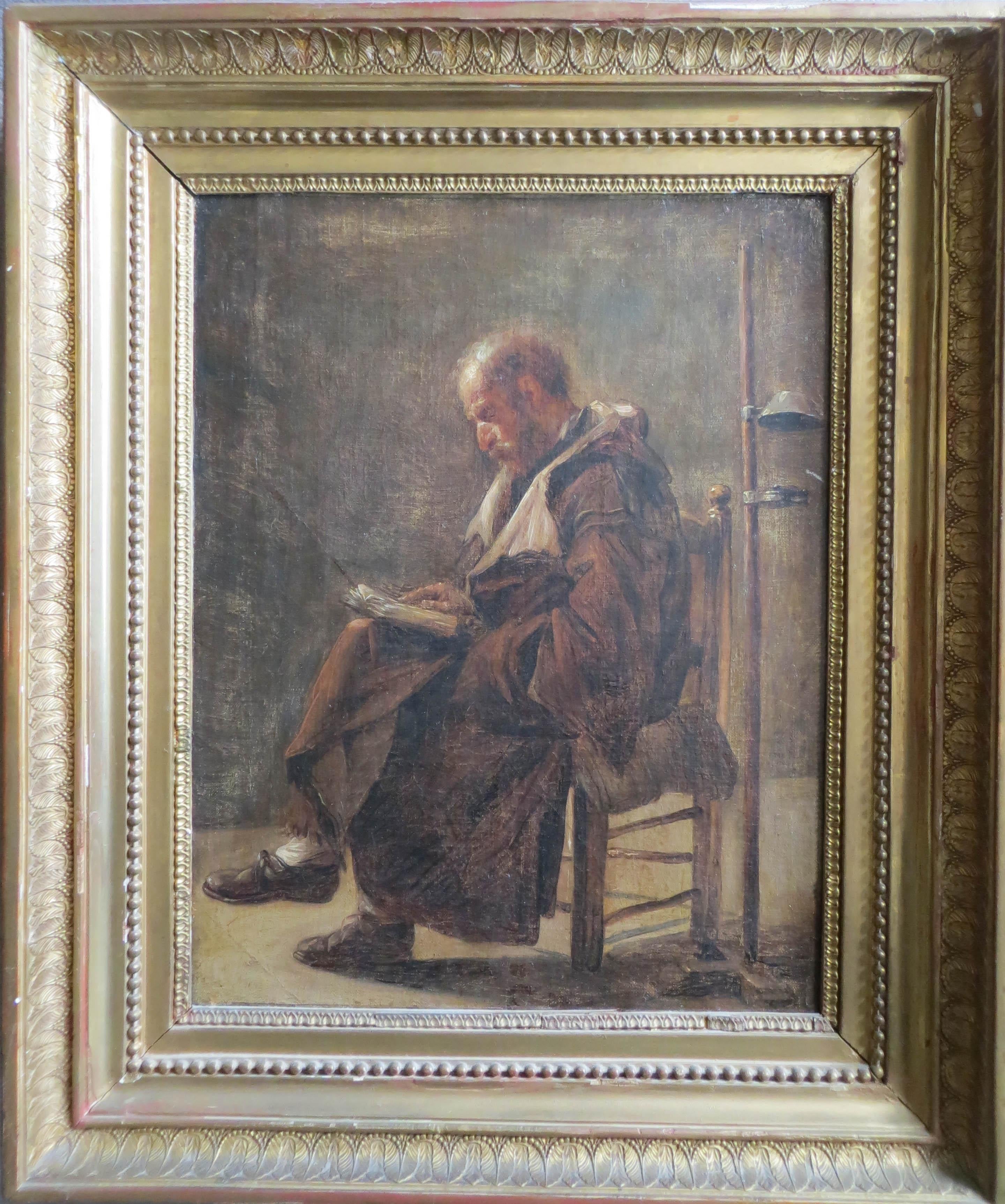Items Similar to J J A Lecomte du Nouÿ (1842-1923) An oriental street, oil sketch
Video Loading
Want more images or videos?
Request additional images or videos from the seller
1 of 10
Jean-Jules-Antoine Lecomte du NouÿJ J A Lecomte du Nouÿ (1842-1923) An oriental street, oil sketch
About the Item
Jean-Jules-Antoine Lecomte du Nouÿ (1842-1923)
An oriental street
oil on canvas
11.5 x 14 cm
no signature
In good condition, canvas without stretcher, simply framed under glass.
In a modern frame : 22 x 26. 5 cm
Provenance:
as indicated on the reverse, Galerie Emeric Hahn, Paris
Private collection, England
An other fine example of oil sketch, for which Lecomte du Nouÿ is reknown and appreciated. But also as we could see it in an other oil sketch of back and shoulder, a fragmental study.
The artist uses the same framing process to paint a fragment that suggests a composition. He leaves it to the imagination of the viewer of his work to complete this fragment. It is in this sense that Lecomte du Nouÿ was a very innovative and surprising artist.
Jean-Jules-Antoine Lecomte du Nouÿ was born on 10 June 1842 in Paris.
Originally of a Piedmontese origin, his family had been settled in France since the fourteenth century and by the time of his birth had reached the status of nobility
He was an Orientalist French painter and sculptor.
He was strongly influenced by the works and teachings of Charles Gleyre and Jean-Léon Gérôme. Lecomte du Nouÿ found inspiration for his art through extensive travels to Greece, Turkey, Egypt, Romania and Italy.
The thematic content of Lecomte du Nouÿ's work was mainly figural, but also spanned over a vast range of imagery throughout his career, including classical, historical and religious.
Lecomte du Nouÿ is known for remaining faithful to his detailed, realistic style throughout the extent of his career, despite the onset of the Impressionist, Fauvist and Constructivist artistic movements during his lifetime. His work is said to have contributed significantly to the establishment of an iconic repertoire representing the Orient in the nineteenth century.A Parisian street was named after him in 1932.
Lecomte du Nouÿ showed a strong attachment to visual art from a young age and was reported to have painted portraits of his father and uncle by the age of 6.
In 1861, at 19 years of age, the artistic talents of young Jean-Jules-Antoine Lecomte du Nouÿ prompted him to become a pupil at the atelier of Swiss artist, Charles Gleyre. Under Gleyre's guidance Jean-Jules-Antoine learned the significance of individualistic style and gained the foundations of creative visual presentation.
Later, Lecomte du Nouy further perfected his knowledge of the artistic form under the mentorship of Jean-Léon Gérôme, who was a renowned painter of the Academicism movement. It was at this time that Jean-Jules-Antoine learned the precision required to depict "la belle nature" —a style of illustration that aims to create the most beautiful representations of the natural form. This later became one of the main techniques employed in Lecomte du Nouÿ's signature artwork.
In 1865, Du Nouÿ accompanied fellow artist, Félix Auguste Clément, on his travels to Cairo, Egypt. It was after this voyage that the young Lecompte du Nouy sought to portray the opulence of the Orient. In later years, he continued his travels, visiting countries like Italy and Greece. Lecompte du Nouy found inspiration in all social, historical and literary facets of foreign culture.
The Orientalist style is largely characterized by its content, but also by its subdued realism and precision allotted towards depicting the human form. The latter is a prominent characteristic of the 19th century methods upheld by the Académie des Beaux-Arts. Du Nouÿ was a prominent figure within the sphere of academic art and thereby adhered to a rule-based artistic style of well-developed skill and formal composition. The artistic composition of his paintings was often complemented by the use of half-light, which added certain dramatic and melancholic qualities to his work. To this day some, like Alan Braddock, consider Du Nouÿ to have been decidedly modern for his time, because his work directly and indirectly broached some of the key issues of his day, albeit from a decidedly conservative perspective: colonialism, international trade, gender, religion, and history. Du Nouÿ spent most of the later years of his life in Romania. There he painted primarily the royal family and their subjects.However, he returned to Paris right before his death on 19 February 1923.
Artworks by Lecomyte du Nouy are held by museums such as Cleveland Museum of Art, Dahesh Museum of Art in New York, Worcester Art Museum, Musée d'Orsay in Paris, Musée des Beaux-Arts de Nantes, etc....
- Creator:Jean-Jules-Antoine Lecomte du Nouÿ (1842 - 1923, French)
- Dimensions:Height: 4.53 in (11.5 cm)Width: 5.52 in (14 cm)
- Medium:
- Movement & Style:
- Period:
- Condition:
- Gallery Location:Paris, FR
- Reference Number:
Jean-Jules-Antoine Lecomte du Nouÿ
Jean-Jules-Antoine Lecomte du Nouÿ was born on 10 June 1842 in Paris. Originally of a Piedmontese origin, his family had been settled in France since the fourteenth century and by the time of his birth had reached the status of nobility
He was an Orientalist French painter and sculptor. He was strongly influenced by the works and teachings of Charles Gleyre and Jean-Léon Gérôme. Lecomte du Nouÿ found inspiration for his art through extensive travels to Greece, Turkey, Egypt, Romania and Italy. The thematic content of Lecomte du Nouÿ's work was mainly figural, but also spanned over a vast range of imagery throughout his career, including classical, historical and religious. Lecomte du Nouÿ is known for remaining faithful to his detailed, realistic style throughout the extent of his career, despite the onset of the Impressionist, Fauvist and Constructivist artistic movements during his lifetime. His work is said to have contributed significantly to the establishment of an iconic repertoire representing the Orient in the nineteenth century.A Parisian street was named after him in 1932. Lecomte du Nouÿ showed a strong attachment to visual art from a young age and was reported to have painted portraits of his father and uncle by the age of 6. In 1861, at 19 years of age, the artistic talents of young Jean-Jules-Antoine Lecomte du Nouÿ prompted him to become a pupil at the atelier of Swiss artist, Charles Gleyre. Under Gleyre's guidance Jean-Jules-Antoine learned the significance of individualistic style and gained the foundations of creative visual presentation.
Later, Lecomte du Nouy further perfected his knowledge of the artistic form under the mentorship of Jean-Léon Gérôme, who was a renowned painter of the Academicism movement. It was at this time that Jean-Jules-Antoine learned the precision required to depict "la belle nature" —a style of illustration that aims to create the most beautiful representations of the natural form. This later became one of the main techniques employed in Lecomte du Nouÿ's signature artwork.
In 1865, Du Nouÿ accompanied fellow artist, Félix Auguste Clément, on his travels to Cairo, Egypt. It was after this voyage that the young Lecompte du Nouy sought to portray the opulence of the Orient. In later years, he continued his travels, visiting countries like Italy and Greece. Lecompte du Nouy found inspiration in all social, historical and literary facets of foreign culture.
Du Nouÿ spent most of the later years of his life in Romania. There he painted primarily the royal family and their subjects.However, he returned to Paris right before his death on 19 February 1923. Artworks by Lecomyte du Nouy are held by museums such as Cleveland Museum of Art, Dahesh Museum of Art in New York, Worcester Art Museum, Musée d'Orsay in Paris, Musée des Beaux-Arts de Nantes, etc....
About the Seller
5.0
Platinum Seller
These expertly vetted sellers are 1stDibs' most experienced sellers and are rated highest by our customers.
Established in 2018
1stDibs seller since 2019
210 sales on 1stDibs
Typical response time: <1 hour
- ShippingRetrieving quote...Ships From: Paris, France
- Return PolicyA return for this item may be initiated within 14 days of delivery.
More From This SellerView All
- P Deltour (?), An artist and his models in the workshop, 1879, oil on canvasLocated in Paris, FRP Deltour (?) French school of the 19th century The artist with his model and friend in his workshop Oil on canvas Signed "P Deltour" (?) and dated 1879 on the lower, an indistinct i...Category
1870s Romantic Portrait Paintings
MaterialsOil
- Dutch school 19th century, A philosopher reading, oil on canvasLocated in Paris, FRDutch school 19th century, A philosopher reading, oil on canvas 27 x 22 cm In a modern frame : 36.5 x 32 cm Recently restored and cleaned, some small inpaintings, thinness of the...Category
1870s Romantic Interior Paintings
MaterialsOil
- French School 19th C, A Renaissance scene with a Lady and a boy, oil on panelLocated in Paris, FRFrench School of the 19th century, Attributed to Achille Deveria (1800-1857) A Lady and a boy with a dog, a Renaissance style scene Oil on wood panel 22 x 13 cm A label on the revers...Category
1840s Romantic Figurative Paintings
MaterialsOil
- 19th Century French school, Two italian women in a landscape, an oil sketchLocated in Paris, FR19th Century French school, Two italian women in a landscape, oil on canvas 59 x 43.5 cm Bears a signature and a date on the lower left (see photograph please) but barely lisible ...Category
1840s Romantic Figurative Paintings
MaterialsOil
- Jean Philippe George-Julliard (1818 – 1888) Landscape with a traveler, oilLocated in Paris, FRJean Philippe George-Julliard (1818 – 1888) A landscape with a traveler Oil on paper Signed HG lower right 19.5 x 29 cm The four corners are cut Framed under glass 27 x 47 cm Jean Philippe George-Julliard (1818–1888) or Henri Philippe Julliard was born on 1 january 1818 in Geneva (Switzerland) from french parents. He first studied art in Nantes in France, but later he came back to Geneva where he became pupil of Alexandre Calame...Category
1860s Romantic Landscape Paintings
MaterialsOil
- French Romantic School, 19th Century, Manly head of bearded man, oil on canvasLocated in Paris, FRFrench Romantic School 19th Century Manly head of bearded man oil on canvas 46 x 37.8 cm In fairly good condition, some inpaintings visible under UV light, mainly in the backgrounds ...Category
1850s Romantic Portrait Paintings
MaterialsCanvas, Oil
You May Also Like
- Lovers at the Fountain - Italian 19th Century Figurative Oil on Canvas PaintingBy Modesto FaustiniLocated in Rome, ITAmanti alla Fontana - Lovers by a fountain, painting oil on canvas, Signed left sight. Measures: cm 70 x 100 frame 118 x 145 Faustini Modesto. Brescia, 27 maggio 1839 - Roma, 23 m...Category
Mid-19th Century Romantic Figurative Paintings
MaterialsOil
- Pompeian Scene 19th century Painting Oil on Canvas Signed Egisto SarriBy Egisto SarriLocated in Rome, ITEgisto Sarri "Pompeian scene" Oil on canvas, measure: cm 30 x 48 with a filly carved gilt - wood frame cm 46 x 64 Signature in the lower left-hand corner: "E. Sarri Egisto Sarri (Figline val d'Arno 1837 - Florence 1901) Sarri studied at the Academy of Fine Arts in Florence under Giuseppe Bezzuoli and Enrico Pollastrini, and was one of Antonio Ciseri...Category
19th Century Romantic Figurative Paintings
MaterialsOil
- Pompeian Scene 19th century Painting Oil on Canvas Signed Egisto SarriBy Egisto SarriLocated in Rome, ITEgisto Sarri "Pompeian scene" Oil on canvas, measure: cm 30 x 48 with a filly carved gilt - wood frame cm 46 x 64 Signature in the lower left-hand corner: "E. Sarri Egisto Sarri (Figline val d'Arno 1837 - Florence 1901) Sarri studied at the Academy of Fine Arts in Florence under Giuseppe Bezzuoli and Enrico Pollastrini, and was one of Antonio Ciseri...Category
19th Century Romantic Figurative Paintings
MaterialsOil
- "Playing hide and seek", 19th Century Oil on Panel by Vicente Palmaroli, SpanishLocated in Madrid, ESVICNTE PALMAROLI y GONZÁLEZ Spanish, 1834 - 1896 PLAYING HIDE AND SEEK signed "V. Palmaroli" (lower right) oil on mahogany panel 17-3/4 x 13-1/2 inches (45 X 34 cm.) framed: 25-1/4 X 21-1/4 inches (64 X 53.7 cm.) PROVENANCE Leslie Hindman Inc., Auctionners Private Collector, Madrid Oil on table by Vicente Palmaroli...Category
Late 19th Century Romantic Interior Paintings
MaterialsOil, Wood Panel
- MonkLocated in Pasadena, CAOil on canvas framed representing a monk reading sitting on a chair in the taste of François Granet.Category
Early 19th Century Romantic Figurative Paintings
MaterialsOil
- Interior of a Church - Oil Painting by Hermann Corrodi, late 1800By Hermann CorrodiLocated in Roma, ITInterior of a Church is an original painting realized by Hermann Corrodi. Original oil on canvas with a contemporary wooden frame included. Hermann David Salomon Corrodi...Category
Late 19th Century Romantic Figurative Paintings
MaterialsOil






